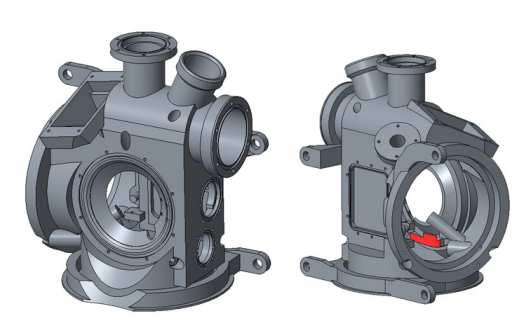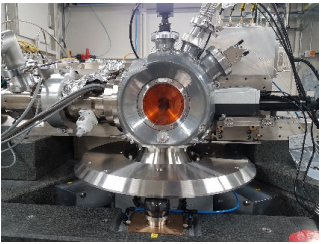Application of additive manufacturing technology in a vacuum environment has been limited due to the material porosity and additives used in the manufacturing techniques. In a paper entitled “The Use of AM Technologies for HV and UHV Components and Vessels,” a group of researchers working at the Diamond Light Source tests PEEK components 3D printed through FDM and metal components 3D printed through DMLS inside an ultra-high vacuum (UHV) environment.
The researchers tested 19 PEEK samples with 100% build density and surface areas of 1.42 cm2 each.
“Testing the samples uncleaned, as delivered direct from the supplier, the outgassing rate reached 1.33 x 10-6 mbar l s-1 cm-2,” the researchers state. “Ultrasonic cleaning in IPA (Isopropyl alcohol) made the outgassing increase to 1.7 x 10-6 mbar l s-1 cm-2. After baking at 150⁰ C for 12 hours the outgassing rate improved significantly to 3.98 x 10-11 mbar l s-1 cm-2 meeting our specifications for use in UHV.”
The results compared favorably to machined PEEK components and, according to the researchers, could potentially be baked longer to improve outgassing rates. They also ordered seven components from the same source, five of which were subjected to visual and dimensional inspection. A few issues were found, including poor surface finish, unpredictable distortion, and unpredictable component shrinkage.
“Detailed inspection reports were carried out on the components using a CMM,” the researchers continue. “Although many feature dimensions were within tolerance, components B, C and D were distorted and warped by up to 1 mm in the extremes. Component E showed no signs of warping and most dimensions within ±0.1 mm. Component A showed no signs of warping, but the internal diameter was 1 mm undersize and the outer flange diameter 0.5 mm oversize.”
They then tested a vessel made from metal using DMLS. There were several build errors and issues with the first prototype, which were then corrected in a later version. Once they had the final prototype, the researchers tested it in a vacuum environment.
“The prototype vessel after being modified, glued and welded, achieved a vacuum pressure of 10-5 mbar, well exceeding the initial specification of 10 mbar and now exceeding the new specification for the vessel of 10-4 mbar,” the researchers state. “This vessel had only been wiped clean with alcohol as a pump and bake was not possible with the painted surfaces…The production vessel was installed onto the VMXm endstation in May 2018 ready for the first experiment. No issues have yet been discovered and the vacuum has reached 10-6 mbar comfortably.”
Overall, the researchers conclude, while 3D printing has come a long way, “it is not always the solution it is cracked up to be.” The quality of the PEEK components was not “up to scratch” for many applications. The process is cheap, however, and offers a quick turnaround. The 3D printed components were vacuum compatible and survived the cleaning process. Complex geometries could be produced, but the end results were unpredictable. The 3D printed PEEK components are not yet ready, the researchers state, to be used as a substitute for machined PEEK components but can be used as a quick replacement when geometry is not critical.
“On the other-hand DMLS offers the ability to produce a very complex vacuum vessel in aluminium quicker and cheaper than conventional methods suitable for HV,” they add. “Changing the material to stainless or coating the seal faces will allow for metal seals to be used and the vessel has the capability of being used for UHV applications 10-10 mbar.”
Authors of the paper include A. Stallwood, G. Duller and D. Butler.
Discuss this and other 3D printing topics at 3DPrintBoard.com or share your thoughts below.
Subscribe to Our Email Newsletter
Stay up-to-date on all the latest news from the 3D printing industry and receive information and offers from third party vendors.
You May Also Like
IperionX Inks 10-Year Deal with Wisconsin Manufacturer for 80 Metric Tons of Titanium Per Year
IperionX, the Charlotte-based supplier of sustainable titanium powders used for additive manufacturing (AM) and metal injection molding (MIM), has signed a ten-year deal with United Stars, a group of industrial...
Gastronology Launches Industrial Production of 3D Printed Food for Dysphagia Patients
Food 3D printing has, in many ways, been an additive manufacturing (AM) segment looking for the right business case. While some applications are beautiful and others may or may not...
Lockheed Martin Leads $3M Investment in Q5D’s Electronics 3D Printing System
Q5D, an original equipment manufacturer (OEM) of robotic arm, hybrid additive manufacturing (AM) systems used for wire harness production, has closed a $3 million investment round. The investment arm of...
3D Printing News Briefs, April 6, 2024: Depowdering, Cybertruck Door Handles, & More
In today’s 3D Printing News Briefs, ioTech’s digital manufacturing CLAD technology is opening up opportunities for microelectronics and additive manufacturing. Hexagon and Raytheon Technologies commercially released the Simufact Additive Process...


































